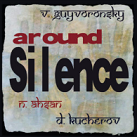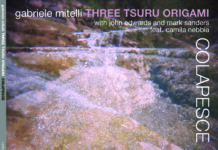 Vyacheslav Guyvoronsky is considered as the best and most representative jazz trumpeter in Russia: Vyacheslav already has a large group of works done with an eclecticism of substance: no doubt, the best feature of Russian is the phrasing, which starts from inevitable Western models but also affected the ethnic factor: in fact, his discography is dotted with several episodes (he passes from the trumpet solo to ensemble), confirming the desire to experience a broader concept of improvised music and the desire to place jazz in a very wide dimension. Guyvoronsky gave evidence of great originality and talent both in the trammels of free improvisation, both in the intersections with classical music, as well as in “ethnic” conjunctions; if we want to follow these stages we have to think to “For Sergey Kuryokhin” (solo trumpet, a tribute to the one of Russia’s most important jazz musicians of all time), a “Delikatessen” (a duet with Nick Sudnik), the three volumes dedicated to classical music that offer a stylistic insight rather heterogeneous, which is a victim of remakes of Bach and Mozart, of the romantic devolutions and modern string quartets with an infiltration in the East (I recommend the intelligent reworking of the “Caprichos” and “Pieces for String Trio & Quartet“), as well as to ethnic inspirations that emerge in the duets with Evelin Petrova.
Vyacheslav Guyvoronsky is considered as the best and most representative jazz trumpeter in Russia: Vyacheslav already has a large group of works done with an eclecticism of substance: no doubt, the best feature of Russian is the phrasing, which starts from inevitable Western models but also affected the ethnic factor: in fact, his discography is dotted with several episodes (he passes from the trumpet solo to ensemble), confirming the desire to experience a broader concept of improvised music and the desire to place jazz in a very wide dimension. Guyvoronsky gave evidence of great originality and talent both in the trammels of free improvisation, both in the intersections with classical music, as well as in “ethnic” conjunctions; if we want to follow these stages we have to think to “For Sergey Kuryokhin” (solo trumpet, a tribute to the one of Russia’s most important jazz musicians of all time), a “Delikatessen” (a duet with Nick Sudnik), the three volumes dedicated to classical music that offer a stylistic insight rather heterogeneous, which is a victim of remakes of Bach and Mozart, of the romantic devolutions and modern string quartets with an infiltration in the East (I recommend the intelligent reworking of the “Caprichos” and “Pieces for String Trio & Quartet“), as well as to ethnic inspirations that emerge in the duets with Evelin Petrova.It’s just this last direction, that of ethnicity, which still characterizes “Around Silence” that tries to integrate his trumpet in the most classic Indian contexts, made of tabla and onomatopoeic singing; here the distance from the more traditional jazz excursions of a “In search of a standard” is significant, and the mood of the compositions is markedly absorbed from the breath of India, despite having all the germs of improvisation. On the other hand, the risk seems to be a constant in the work of Guyvoronsky, whose value is to seek a symbiosis with sounds even formally distant from his interpretation of jazz; so the most interesting aspect of “Around Silence” lies in the desire to identify himself with the problematic chant of Ahsan and in the raga dictated by the cadences of the tabla player Kucherov.
_______________________________________________________________________________
Vyacheslav Guyvoronsky è considerato come il più bravo e rappresentativo trombettista jazz in Russia: Vyacheslav ha già una carriera nutrita fatta di lavori realizzati in condizioni di eclettismo non fine a sè stesso; senza dubbio la migliore caratteristica del russo è il fraseggio, che pur partendo da inevitabili modelli occidentali, è molto personale e risente anche del fattore etnico: infatti la sua discografia è costellata di vari episodi (dal solo all’ensemble) che dimostrano che una delle prerogative principali del trombettista è quella di sperimentare un concetto più ampio di musica improvvisata e di inserire il suo jazz in una dimensione quanto più vasta possibile. Guyvoronsky ha dato grandi prove di originalità e talento sia nelle pastoie della libera improvvisazione, sia nelle intersezioni con la musica classica, nonchè in quelle “etniche”: per seguire queste varie fasi si pensi al solo “For Sergey Kuryokhin” (omaggio ad uno dei musicisti jazz russi più importante di sempre), a “Delikatessen” (in duo con Nick Sudnik), ai tre volumi dedicati alla musica colta che offrono uno spaccato stilistico piuttosto eterogeneo, vittima dei rifacimenti di Bach e Mozart, delle devoluzioni romantiche e dei quartetti d’archi moderni anche infiltrati in Oriente (tra cui spiccano le intelligenti rielaborazioni dei “Caprichos” e i “Pieces for String Trio & Quartet“, nonchè agli afflati etnici che emergono nei duetti con Evelin Petrova. E’ proprio su questa direttiva ultima, quella dell’etnicità, che si muove ancora “Around Silence” che prova ad inserirsi nel più classico dei contesti indiani, fatto di tabla e canto onomatopeico: è un’operazione piuttosto difficile quella di “Around Silence“, distante dalle escursioni jazzistiche più tradizionali di un “In a search of standard“; è nettamente assorbito dal respiro indiano, pur avendo tutti i germi dell’improvvisazione. D’altro canto il rischio sembra essere una costante del lavoro di Guyvoronsky, il cui pregio è quello di cercare una simbiosi con suoni anche formalmente distanti dal suo modo di interpretare il jazz; ed è proprio nella voglia di immedesimarsi con il problematico canto di Ahsan e nei raga dettati dalle cadenze del tablista Kucherov che risiede l’aspetto più interessante di “Around Silence“.







